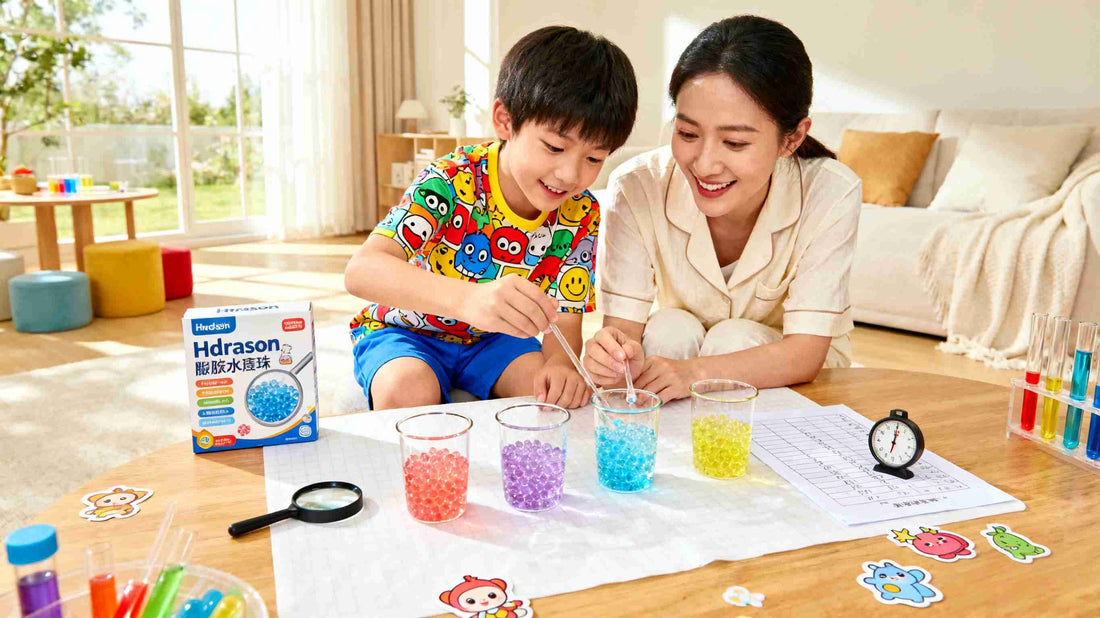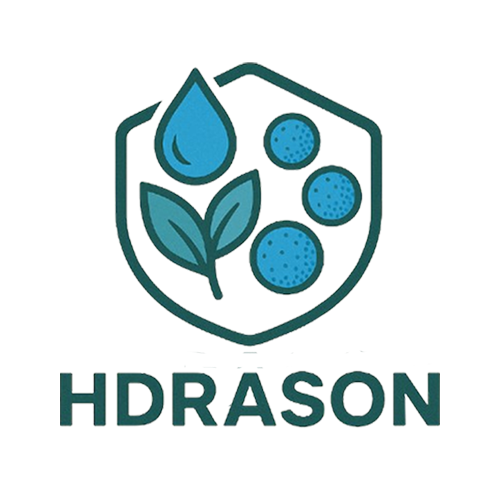
The application of Hdrason water beads in early childhood education: stimulating exploration and cognitive development
Share
In early childhood education, touchable and explorable teaching aids have always been key to inspiring children's active learning. Children aged 3-6 are in their prime period of sensory development and cognitive enlightenment, building their understanding of the world through hands-on touch, eyes-on sight, and brain-powered imagination. Hdrason water beads, due to their safety, non-toxicity, soft texture, and adaptable shape, have become a popular "low-structured" teaching aid in early childhood education in recent years. They not only satisfy children's natural instinct for hands-on exploration, but also cleverly integrate multi-dimensional educational goals such as sensory, cognitive, scientific, and social development.
The Core Advantages of Hdrason Water Beads: Why are they suitable for early childhood education?
Before discussing their application, we must first address the core concern of parents and teachers: safety.
Hdrason water beads are made of a food-grade, water-based material that contains no harmful substances like formaldehyde and heavy metals. Even if a child accidentally touches them with their mouth or nose (adult supervision is required to prevent accidental ingestion), there's no risk. Their texture is as soft as a sponge, and they quickly rebound after being squeezed, preventing scratches on delicate skin. They're also easy to clean and reusable, returning to cleanliness with a simple rinse. They're perfect for group activities in kindergartens and family interactions.
More importantly, their unstructured nature—no set rules for play—allows children to freely manipulate them according to their own ideas. This open-ended nature perfectly complements children's self-centered cognitive nature, maximizing their initiative to explore and avoiding the constraints of traditional teaching aids.
Five Educational Applications of Hdrason Water Beads: Progressing from Exploration to Cognition
1.Sensory Exploration: Awakening Children's Five Senses
Children's cognition begins with sensory experience. The tactile and visual changes of Hdrason water beads precisely activate children's tactile and visual development:
- Tactile Exploration Activity: Place dry Hdrason water beads (tiny particles) and soaked water beads (plump, transparent) in a tactile tray. Instruct children to pinch, press, and rub them with their fingers. Children will intuitively experience the texture changes from "hard to soft" and "small to large," and describe the textures of "like sand" and "like soft jelly." This experience enriches children's tactile vocabulary and enhances their tactile sensitivity.
- Visual Observation Activity: Place Hdrason water beads of different colors (e.g., blue, yellow, and red) into a clear glass bottle and add a small amount of water. Children will observe the water beads' expansion in the water: within an hour, they transform from small particles into plump beads, their color gradually becoming translucent. If two colors of water beads are stacked (e.g., yellow and blue), they will also see a visual surprise: they "turn green," laying the foundation for subsequent color recognition.
2.Cognitive Enlightenment: Understanding "Basic Concepts" through Play
Children aged 3-6 years old primarily rely on concrete and figurative thinking. Hdrason water beads can help children understand abstract concepts (color, quantity, shape, and classification) through figurative play:
- Color and Sorting Game: Prepare Hdrason water beads in red, yellow, and blue colors, along with corresponding colored paper plates (red, yellow, and blue). Guide children to sort the water beads "home" by color. During the activity, teachers can ask questions like, "Which plate should the red water droplets go in?" or "Let's count how many water droplets are in the red plate?" This not only strengthens color recognition but also develops hand-eye coordination and counting skills.
- Shape and Spatial Games: Use molds (round, square, or triangular silicone molds) to press moistened Hdrason water droplets into corresponding shapes, or use water droplets to "build simple shapes" on a puzzle board (e.g., using round water droplets to build a sun, or square water droplets to build a house). Through these activities, children will gradually understand the characteristics of different shapes and develop a preliminary understanding of spatial combination.
3. Scientific Inquiry: Sparking the Curiosity of "Little Scientists"
The physical properties of Hdrason water beads (water absorption, expansion, and solubility) are excellent materials for early childhood science education, allowing children to experience scientific phenomena through hands-on activities:
- "Water Beads Drink Up Water" Experiment: Children are given transparent cups, dry Hdrason water beads, and measuring cups. They are asked to add 10ml, 20ml, and 30ml of water to the cups and observe the changes in the expansion of the water beads. "Add 10ml of water, and the beads only get a little bigger; add 30ml, and they become plump!" Through comparison, children can intuitively perceive the relationship between the amount of water and the size of the beads, and begin to establish the concept of "variable."
- "Where Do the Water Drops Go?" Experiment: Place moist Hdrason water droplets on a paper towel, a plastic sheet, and a leaf. Observe the changes in the water droplets on the different materials. The water droplets on the paper towel will gradually "shrink" (absorbed by the paper towel), the water droplets on the plastic sheet will maintain their shape, and the water droplets on the leaf will "roll" as the leaf tilts. This process allows children to discover the differences in water absorption among different materials and cultivate the scientific thinking process of "observation - questioning - thinking."
4. Social Cooperation: Learn to "share and collaborate" through interaction
The development of "social skills" is crucial in kindergarten education. Group games designed with Hdrason water droplets can promote cooperation and communication among children:
- "Water Drop Passing" Game: Divide children into groups of 3-4. Each group is given a tray with 10 Hdrason water droplets. Children are asked to use a spoon to pass the water droplets from the "starting tray" to the "ending tray" without dropping them. If a drop of water falls, the group must pick it up and start over together. This will naturally teach children to slow down and remind each other, and they'll understand that teamwork is essential for completing tasks.
- "Water Drop Playground" Construction: Provide materials such as Hdrason water drops, building blocks, twigs, and cotton. Have groups work together to build a "Water Drop Playground" (e.g., using building blocks to build a "bridge" and placing water drops on the "bridge deck"; using cotton to make "clouds" and placing water drops under the "clouds" as raindrops). During the construction process, children will discuss "who builds the bridge" and "where to place the water drops to create the best look," honing their communication and collaboration skills.
5. Cultivating Creativity: Let Imagination Grow
The greatest advantage of low-structure teaching aids is that they stimulate creativity. Hdrason water beads can be combined with a variety of materials, allowing children's imaginations to take shape:
- "Water Bead Art": Dip moistened Hdrason water beads in non-toxic paint (watercolor or food coloring) and press them onto white paper to create a "dot painting." Children can create a "rainbow garden" (flowers made of different colored dots), a "rainy day" (raindrops made of blue dots), or even use the translucency of the water beads to create gradient effects, experiencing the joy of using a non-traditional brush.
- "Water Bead Story": Use Hdrason water beads, small dolls, and building blocks to create scenes and let children make up stories—for example, "A little bear finds colorful water beads in the forest and gives them to a little rabbit as a gift. The little rabbit uses the water beads to grow colorful flowers." Through these creative activities, children's language skills and imagination are fully developed.
Precautions for Using Hdrason Water Beads
Safety First: Although these are safe teaching aids, ensure that children use them under adult supervision to prevent accidental ingestion (recommended for children aged 3 and above, and emphasize "Do not put in mouth" before each activity).
Appropriate Guidance: Avoid directly telling children "what to do." Instead, use questions (e.g., "What do you think will happen if you put a water bead here?") to allow children to explore independently.
Material Combination: Incorporate everyday materials (e.g., cups, spoons, leaves) to reduce the cost of teaching aids while allowing children to experience "educational materials in everyday life."
Cleaning and Storage: After the activity, rinse the water beads with clean water, dry them, and store them in a sealed container. They can be reused for 2-3 months (replace them promptly if they become damaged or discolored).
Conclusion: Hdrason Water Beads – Letting Children Learn Through Exploration
The educational value of Hdrason Water Beads lies not in how much knowledge they can "teach" children, but in the opportunities they provide for independent exploration. When children pinch a bead between their fingers, observe how it shines in the sun, and experiment with combining it with other materials, they not only develop their senses, cognition, and creativity, but also cultivate a curiosity and love for the world. For early childhood education, this "joy of exploration" is far more valuable than memorizing knowledge points.
In the future, we look forward to seeing more "safe, open, and fun" teaching aids like Hdrason Water Beads introduced to kindergartens, allowing children to naturally grow into exploratory, thoughtful, and cooperative learners through touch, observation, and collaboration.
Next article:Hdrason Water Beads Safety Guide
